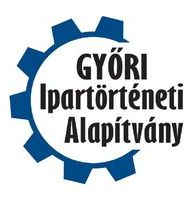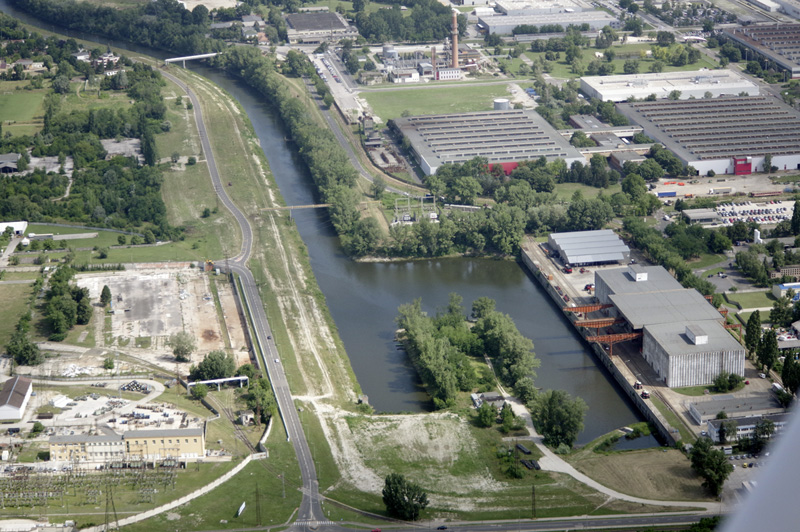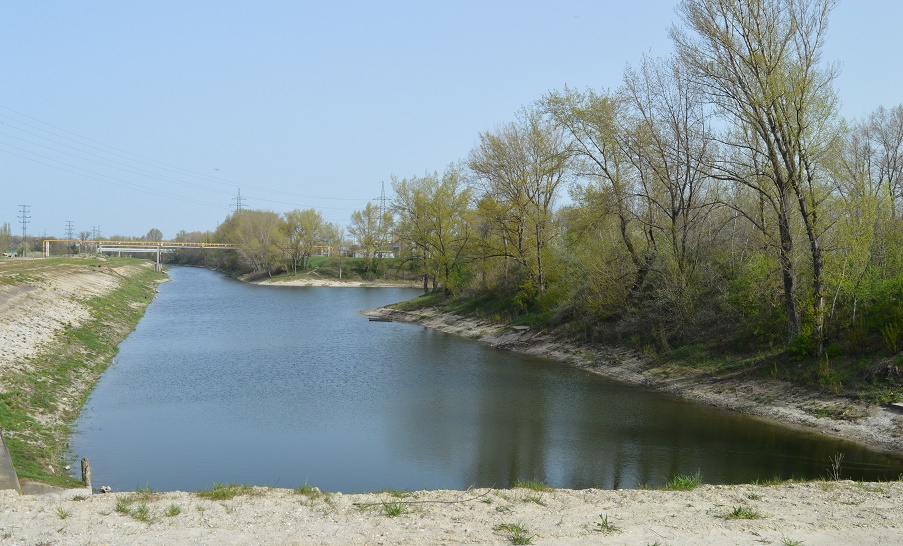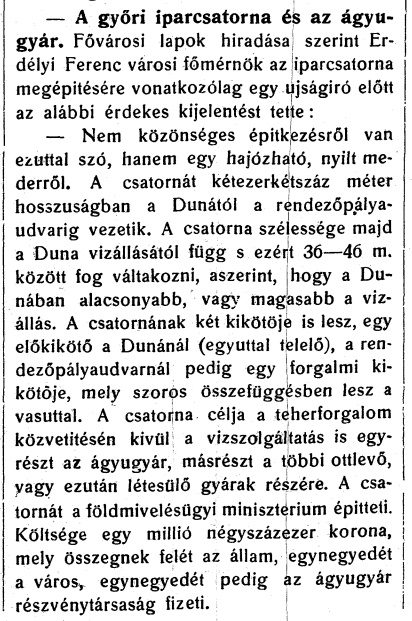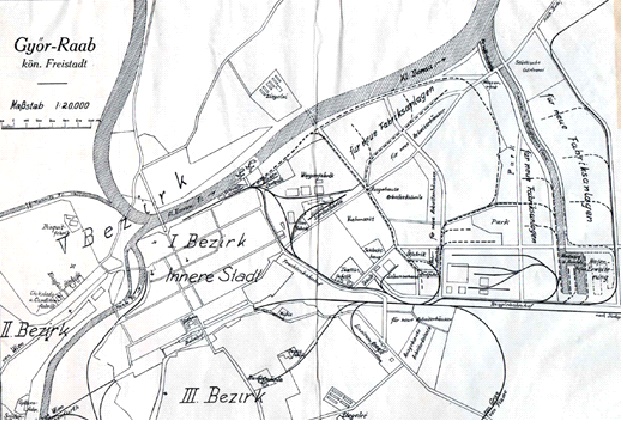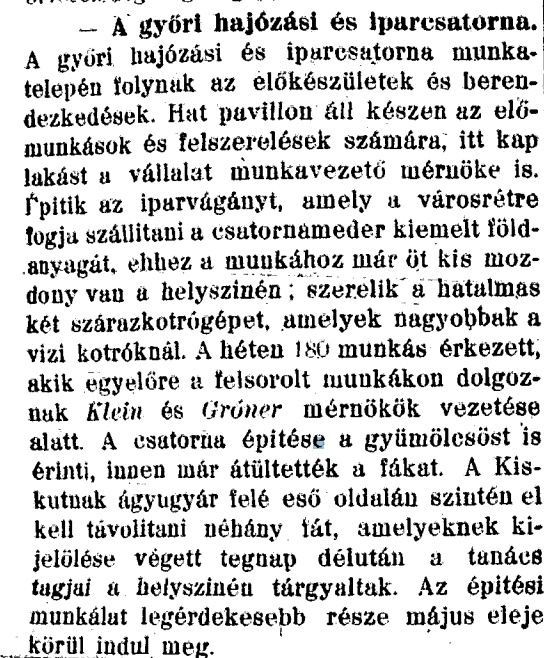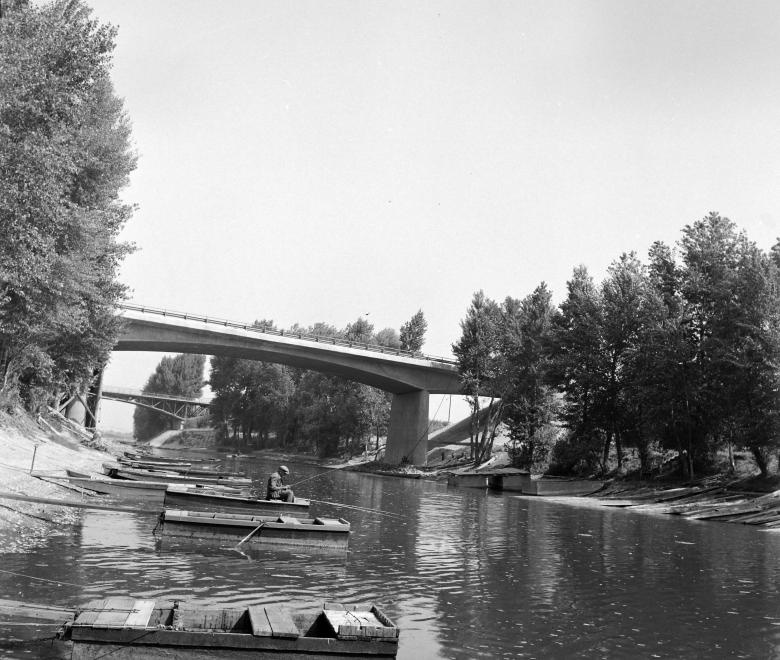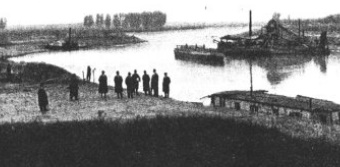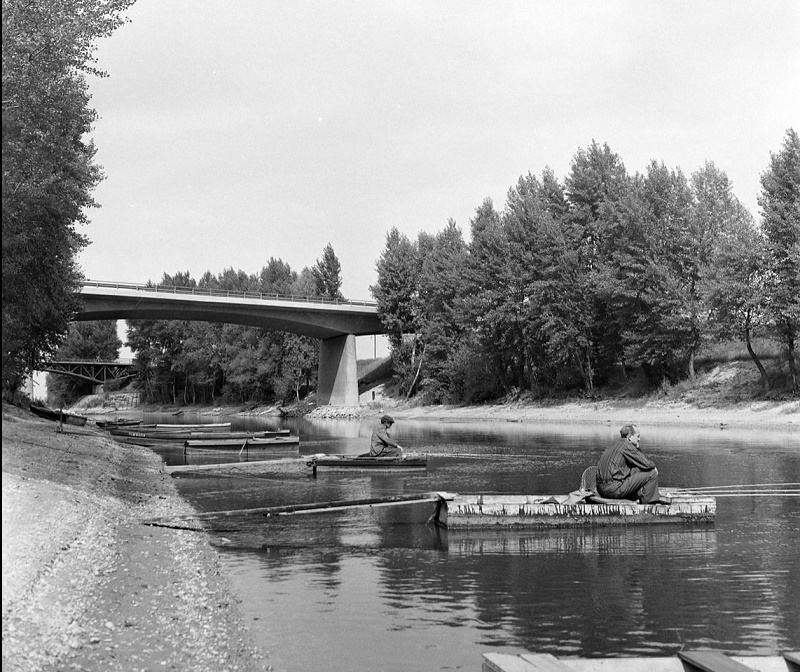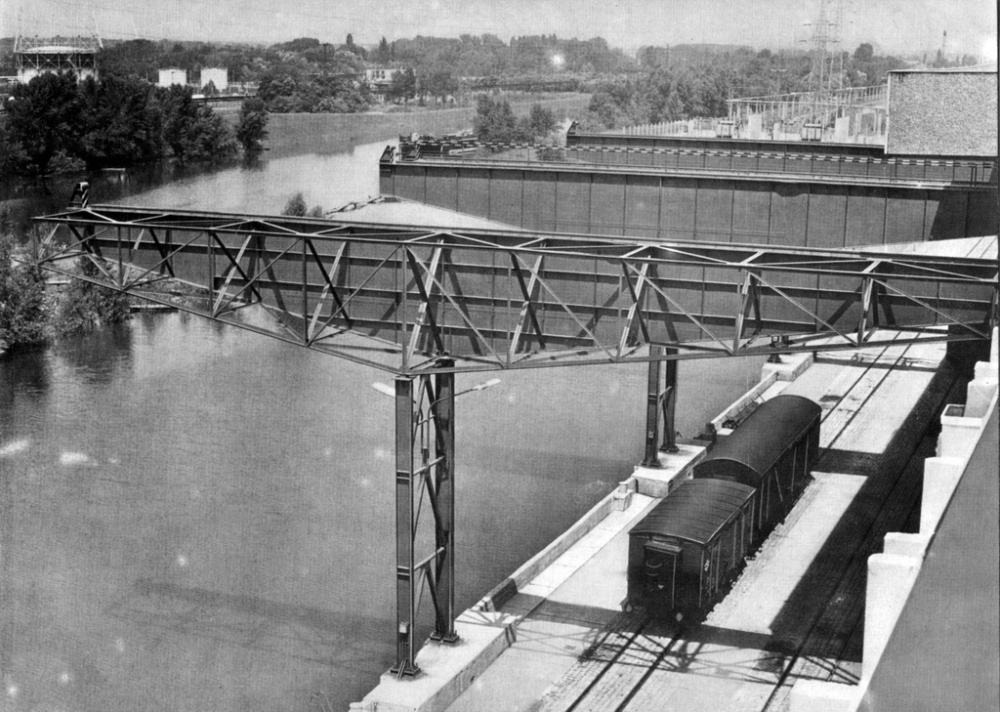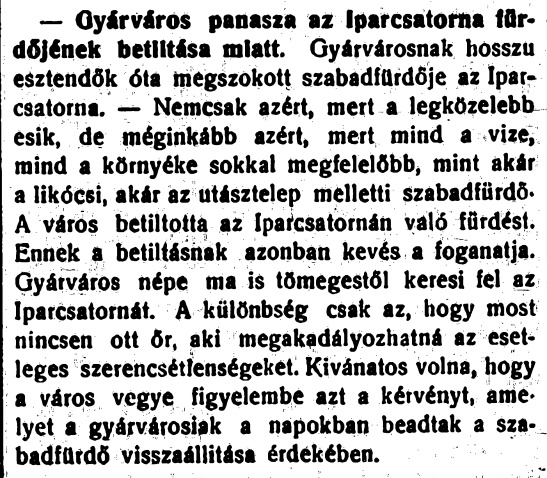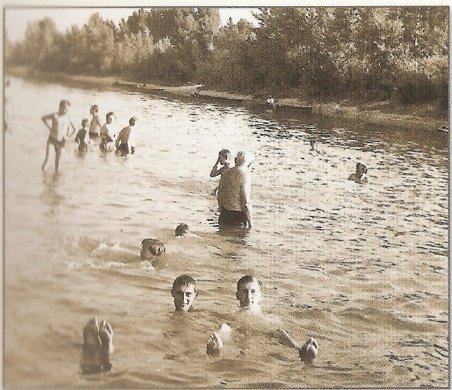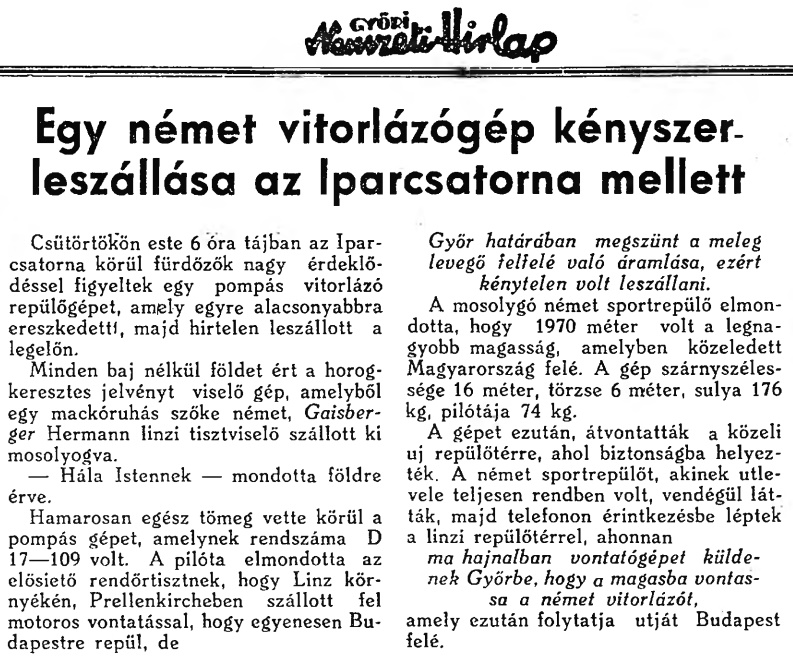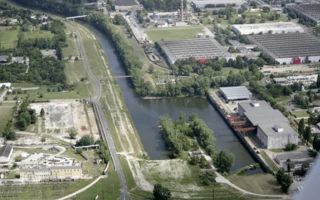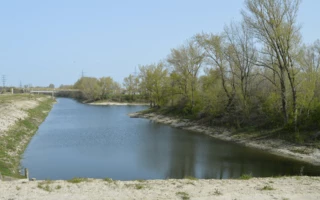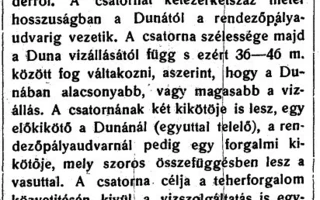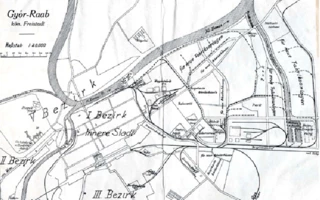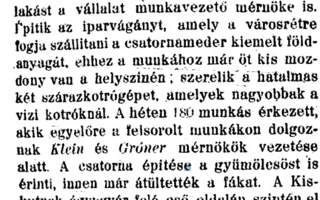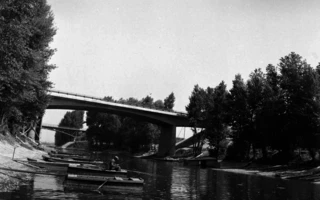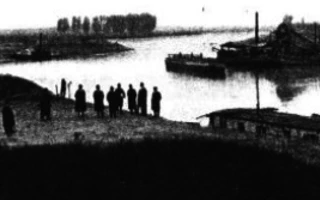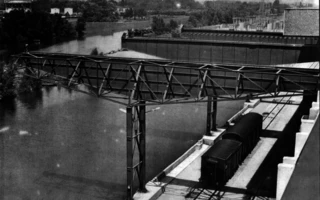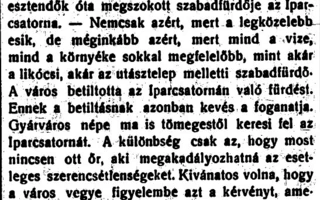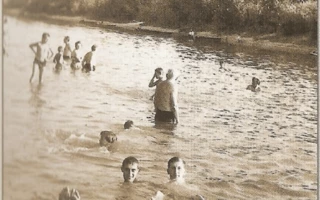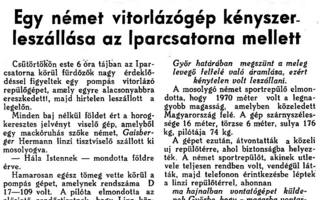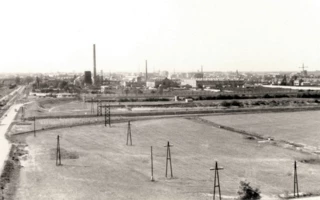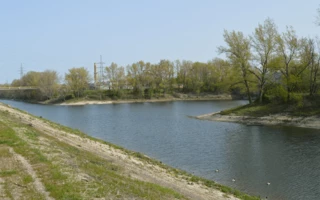Contact details
Foundation for Industrial History of Győr
Szent István út 10/a
Phone:
+3696520274
Fax: +3696520291
E-mail:
ipartortenet@ipartortenet.hu
Map
Industry channel
| Address of the memorial site, route planning | ||
| What can we see at the memorial site? | ||
| Detailed story | ||
| Interesting facts | ||
| Literature, references | ||
| Related gallery | ||
| Next stop of the first round trip |
| ADRESS OF THE MEMORIAL SIT |
| WHAT CAN WE SEE AT THE MEMORIAL SITE? |
The memorial site is located at the end of the Industrial Canal towards Kandó Street, in the so-called “square”. The bronze disc sunk into the pavement is next to the road entrance to the ÁTI-DEPO public warehouse, and the memorial site is located at the end of the concrete road leading to the fishing pond, on the peninsula between the two branches of the canal.
The Industrial Canal has preserved almost its original condition even today, although it is no longer suitable for navigation due to the construction of an artificial structure at its mouth. The lock built in 2013 made it unnecessary to maintain the embankment built on the city side of the canal, which was therefore demolished. The silt extracted during the dredging was deposited on the Gyárváros side of the canal.
On the side facing Airport Road, the landing through which the amphibious water vehicles once set off on a test run in the canal can still be seen today.
A new bridge was built in 2018 at the mouth of the Industrial Canal – on the exit section of Road 1 .
Street View:
-
Aerial photo from our days:
The Industrial Canal, with the peninsula known as the "square".
On the left is the former cannon factory, on the right is the ÁTI DEPO ZRt. (Public Warehouse).
Aerial photo: Andorka Zsolt, 2018
A picture from our day:
Industry Channel, 2017
Photo: Dr. János Honvári
| DETAILED HISTORY |
The 2.4 km long Industrial Canal – various sources give the canal's length between 2200-2500 meters – which was the country's first navigable canal built specifically for industrial purposes , is closely linked to the history of the former Cannon Factory.
This canal, built at the expense of the city, the Cannon Factory and the state, originally had four purposes. It primarily served the Cannon Factory's industrial water needs, but it was also intended to be used for the water transport of materials necessary for production and finished guns. The Cannon Factory's daily industrial water needs were estimated at 40,000 cubic meters, which was eight times the city's daily water consumption at the time. Building a closed pipeline that could transport this amount of water would have been disproportionately expensive. That is why it was decided to build a canal with a bed width of 30 meters and a bottom width of 12 meters, the first concept of which was prepared by the city's chief engineer Ferenc Erdélyi , who overly optimistically calculated that with such a bed width, two of the largest Danube barges could fit at the same time, even at the lowest water level.
The construction plans were reported in detail in an article published in the Győri Hírlap on April 12, 1914.
Népakarat, 1915. Jan. 31. No. 3. p. 3.
Source: http://edok.gyorikonyvtar.hu/
Secondly, the undeveloped area of approximately 150 acres west of Puskás Tivadar Road, bordered by the Ipar Road – Vienna – Budapest main road and the planned Ipar Canal, would have provided an opportunity for about 20 factories to settle. The city wanted to establish a new factory district, a kind of “industrial park” in today’s terms , on the land it owned. The Ipar Canal would have provided water, the Mosoni-Danube would have provided navigation, and it would have been possible to connect to the nearby railway with an industrial track. Thirdly, they wanted to establish a winter port at the connection of the Ipar Canal to the Mosoni-Danube . Fourthly, they wanted to fill in deep, floodplain and wave-plain areas with the soil excavated from here , where new factories could be established.
Map of the city with the Industrial Canal under construction
Source: Free Royal City and County of Győr. Budapest, 1926.
The canal was built from the right bank of the Mosoni-Danube to the Ágyúgyár and practically completely divided the urban area in two, so that in the long term a series of factories could find sites on the other side (the later airport). The first plans, drawn up in the spring of 1914, did not yet include the establishment of ports, so the costs of the canal construction were estimated at 750 thousand crowns. However, the idea soon changed , and in May 1914, two ports were planned to be built. In addition to the winter port, at the other end of the canal, at the Ágyúgyár, in the neighborhood of the MÁV freight station, which at that time only existed in ideas, next to the Budapest–Hegyeshalom railway, the construction of a so-called traffic port was also taken into account, so the planned costs almost doubled. However, due to the establishment of the public port, they could count on a significant amount of state support. The originally planned costs of 1.4 million crowns increased to 1.5 million at the start. In 1915, the Council of Ministers voted for a budget subsidy of 800,000 crowns for the construction of the Győr Industrial Canal, the remaining 700,000 crowns were borne by the city and the Artillery Factory in a 50/50 ratio. This created the theoretical possibility of transferring goods arriving on barges to wagons here. The traffic port was sized so that 8 ships could load in a row at a time. The port, divided in two by a pier, could have accommodated 16 ships or barges at a time. As we know, this solution did not materialize, as the traffic port has two “legs” of unequal length.
Győri Hírlap, 1915. No. 97. Apr. 25. p. 5.
Source: http://edok.gyorikonyvtar.hu/
The plans for the canal construction were prepared by the Komárno River Engineering Office, and the Budapest company Freund Henrik and Son was entrusted with the construction work. The canal was supposed to be handed over in working order by November 30, 1916. In the meantime, however, it turned out that much more land had to be excavated than planned, so a supplementary contract was concluded, and the handover deadline was modified to June 30, 1917. In addition to the construction of the Ipar Canal, the Budapest company was also commissioned to build two bridges . The reinforced concrete bridge on Buda Street spanning the canal was built by the contractor between August 30, 1915 and September 28, 1916, and we have no information about the construction of the other crossing.
In the background is the old Industrial Canal Bridge, in front is the bridge of Highway No. 1. 1968
Source: http://www.fortepan.hu/
The first two months were spent in preparations, laying the light railway track for transporting the excavated earth, and transporting and assembling the two dry-cast excavators to the site. In April 1915, 180 people worked on the preparatory work.
The first excavator started working on May 21, the second on June 23, until then only manual excavation was carried out. The work was greatly hampered by the discovery of a layer of limestone about 20 cm thick in the ground, which had to be removed by blasting and hand picking. A large alluvial rock crushed the scaffolding of one of the excavators on July 15, 1915.
Works on the Industry Channel
The contractor stopped the excavators on November 16, 1916, because he felt that he could not meet the deadline agreed to in the contract. He wanted to force a change in the completion deadline by stopping work, but the city would not hear of it. The dispute between the client and the contractor did not lead to any results, but nevertheless on December 13, 1916, one excavator, and then shortly after the other, started working again. Due to the severe frosts, they were unable to work during the winter of 1916/17. Work resumed in the spring of 1917. The contractor, citing rising prices and other reasons, demanded an increase in the agreed amount by 1.5 million crowns, in return for which the city was willing to increase it by 750,000 crowns, but only if the company met the agreed deadline. The work was increasingly hampered by the worsening coal shortage, and it was also becoming increasingly difficult to provide food for the workers. After several minor and major stoppages, the dredging of the traffic harbor was completed on May 17, 1918. Due to the contractor's reluctance, the city withdrew the remaining work from the Budapest company on May 25, 1918, and from then on only minor land clearing was carried out.
Bridges on the Ipar Canal, 1969
Source: http://www.fortepan.hu/
Prisoners of war also worked on the construction of the Cannon Factory and especially the Industrial Canal from 1915. The first contingent, 300 Russian prisoners of war, arrived in Győr in the summer of 1915, where they were guarded by 30 soldiers. The Cannon Factory built barracks to house them. The Russian prisoners of war began to escape in the summer of 1917, and all the forced laborers left when the news of the Aster Revolution broke out in 1918. The contractor declared the work completed on December 6, citing a shortage of labor and coal. About 400 meters of wet dredging was not completed on the Mosoni-Danube side, at the mouth, and therefore the canal could not be used for navigation or winter harboring of ships until the mid-1920s.
According to a report dated August 30, 1926, the construction of the Industrial Canal between 1915 and 1923 cost a total of 1,572,440.17 (certainly in pre-war, still valuable gold crowns). During the construction of the work, approximately 917,000 cubic meters of earth and 800 cubic meters of stone were extracted. The foreport, which originally required the extraction of approximately 75,000 cubic meters of earth, was not completed, and the city and the builder agreed to abandon it on February 24, 1916.
The Industrial Canal with the Public Warehouse
The canal, which stretches from the Mosoni-Danube to the Ágyúgyári site for about 2,400 meters, is on average 32 meters wide, 3-8 meters deep, and 16 meters wide at the bottom. Although a traffic port was built on the side of the Ágyúgyár, partly due to "circumstances" and partly due to the contractor's repeated demands, the mouth part remained undragged, so the entire structure remained unusable for its intended purpose.
In the early 1920s, Győr repeatedly wrote to the state to complete the Industrial Canal, and the state budget would take on the financing of the pending – not very significant – works. The city council referred to the fact that in the Treaty of Trianon the country had lost the winter ports of Bratislava and Komárom, and to replace them, the Minister of Agriculture should order the dredging of the remaining 400 meters of estuary water and the construction of the related protective works from state budget funds. In exchange for the financial resources, Győr leased the winter port to the state for 25 years free of charge.
The canal was finally completed only after World War I, in 1925, but it was only used for navigation during World War II . The fighter planes produced in the aviation department of the Wagon Factory were transported from the factory on a special motorized barge on the Mosoni-Danube, then on the Industrial Canal to the airport, where the fuselage was hoisted up to the airport hangar with a winch, where the plane was assembled, flown in and its armament was loaded.
The compilation was based on the study of Dr. János Honvári.
| INTERESTING FACTS |
|
The people of Győr once used the Industrial Canal as a public beach, its water was warmer than that of the Mosoni-Danube. Dunántúli Hírlap, 1932. Jul. 13. No. 156. p. 3. In July 1932, the city again permitted bathing in the Industrial Canal, with the proviso that only those who could swim should enter its waters. Bathers in the Industrial Canal in the 1950s Győri Nemzeti Hírlap, 1938. Aug. 5. No. 173. p. 5. |
| LITERATURE |
- 2007. Gyárváros in Győr. The story of a workhouse. Edited by Orbánné Márta Horváth. Győr, Gyárváros Friends' Circle Association. 152 pages.
- 2010. Mihály Krámli: The establishment of the Győr Hungarian Artillery Works 1911–1914. In: Military History Publications, 123rd vol. 4th no. December. pp. 1005-1014.
- 2011. Resolution of the general assembly of the city of Győr regarding the discounts given to the cannon factory to be built. In: Győr, the model-changing city 1868-1918. Győri Tanulmányok, 33. no. Győr, pp. 237-239.
- 2014. Ádám Adorján: History of Gyárváros. https://prezi.com/v0ea93gk3da6/gyarvaros-tortenete
2015. Béla Kulcsár: The Győr Cannon Factory was built a hundred years ago. In: Hegyalja, May, June, July.
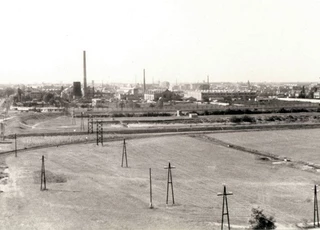
Related gallery
Back to the previous page!
